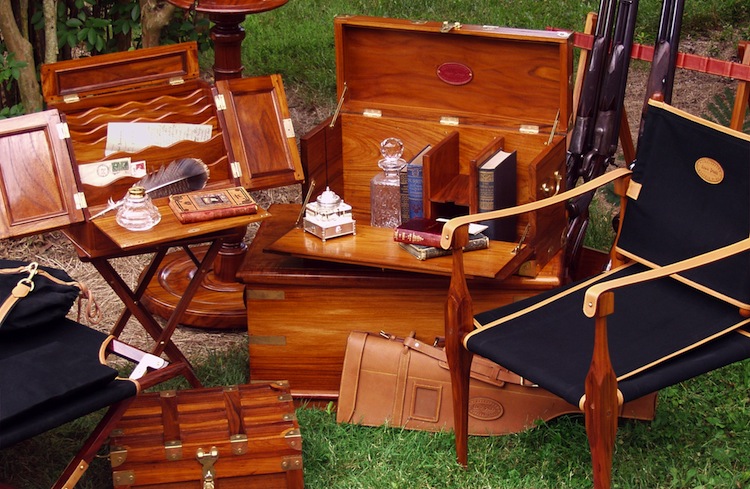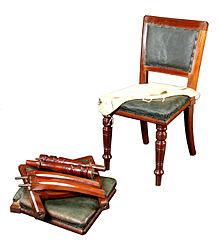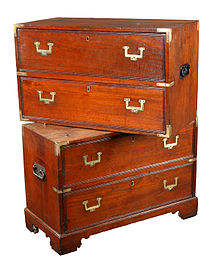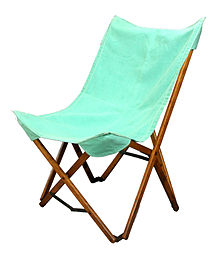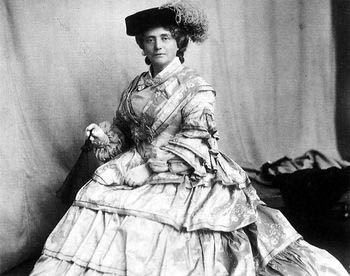Campaign furniture is relatively rare, so it’s unlikely that you will come across it in an everyday auction or a dealer’s shop. It is basically any furniture made specifically for travel, being designed in such a way that it could be carried with ease, with either chunky brass handles or dismantled completely to be packed away for long voyagers.
Although this type of furniture has been in use in basic form for thousands of years, it was the British during the eighteenth and nineteenth century who really took it to a new level of luxury and ingenuity. With the rise and expansion of the empire, the British gentleman found himself transplanted into far-flung and alien parts of the world.
Whether he was an officer in the army, something in the colonial government, or involved in trade and commerce, the British gent needed to live his life as if he were back home in Britain. He had no desire to fit in with the local ways and customs, so he did everything possible to re-create life as it had been back home. A gentleman required a certain level of comfort, so the furniture to which he was accustomed back home in his townhouse would need to be replicated while he was camping in a tent in the desert or furnishing his new palace in Bombay.
Some of the best furniture makers of the day were cashing in on the requirements of this new breed of wealthy traveler, and Chippendale was amongst those that fought over lucrative contracts to supply unbelievably copious amounts of the finest campaign furniture – also known as knockdown furniture – that was destined for the colonies.
This knockdown or campaign furniture was as clever as it was tasteful and fashionable. Some great examples are a writing bureau that, when the drawers were removed, a few levers pulled, and feather cushions added, could convert into a bed, and mahogany dining tables capable of seating 20 people – in the middle of the jungle – that could break down into components small enough to fit into a 10-inch-deep box. A ladies’ bidet that, when not in use, converted into a leather traveling case.
A fascinating publication of the nineteenth century was called The Complete Indian Housekeeper and Cook. Aimed squarely at highborn Brits living in India during the golden years of empire, it advised its readers that while traveling up-country, the first rule of camp was: “do not make yourself uncomfortable for want of things to which you are accustomed.”
The Honorable Emily Eden subscribed to this magazine.
Emily set off up-country from Calcutta with her sister and brother, the governor-general of India, for a little break way from the hustle, bustle, and heat of the city. She took with her a few pieces of campaign furniture and other requirements to keep her comfortable while out camping. Carrying Emily’s gear were 60 horses, 140 elephants, 200 baggage camels, and bullock carts that stretched off into the sunset and 12,000 camp followers to help out a bit.
Campaign furniture wasn’t used only on land, either. Those traveling to India or Africa would spend up to three months at sea. Most of us would have spent the voyage being sick in steerage, but the lucky few who could afford large cabins needed furniture. Campaign furniture was perfect, as it could be easily packed away and stored if the captain ordered it, as he might have done because of bad weather – or in case the decks needed to be cleared to make way for cannon and fighting should the ship be threatened by pirates or an enemy man o’ war.
Because the campaign furniture was as fashionable, stylish, and of the same quality as the furnishings back home, once landed safely in port the same furniture used at sea could then be used to furnish the new homes in the colonies, or if their travels continued it would make life that much more bearable and civilized whilst living under canvas.
The most famous of all types of campaign furniture must be the Wellington chest. These were tall and narrow chests of drawers with a hinged side flap which locked over the edges of the drawers. This unique locking system prevented the drawers from opening in transit, and also protected the drawers’ contents from unwanted hands while living in camp.
Wellington chests date from the early part of the nineteenth century, around the time of the Napoleonic wars, and were named after the Duke of Wellington. There are no locks on the drawers, as the locking side-flap provides all the security, and on some of the more expensive Wellington chests, a false drawer disguises a pull-out writing surface. For the travelling naturalist of the day, or collector, a Wellington chest might have been fitted out as a specimen chest with the drawers lined with cloth, or fitted with compartments to receive such items that were valuable and treasured at the time as eggs, butterflies, insects, fossils, and the like.
For wealthy British army officers or merchants abroad, ordinary campaign furniture was not enough. They required wine tables, bookcases, games tables, four-poster beds, and reclining chairs, to mention just a few necessities. There was also an element of competition, particularly between army officers, as to who could furnish his tent in the most fashionable and affluent manner; some had fireplaces built under canvas, and some even had electrified lamps. The big irony here, though, is that the more portable the furniture became, the more the army officers and colonialists ordered to take on their journeys. This was great news for the furniture makers back in Britain, but in order to transport the fabulously transportable campaign furniture, the travelling adventurers had to hire even more elephants, horses, oxen, and paid help!
Who Made Campaign Furniture?
The Army & Navy Society’s followed on from a strong British tradition of innovative and practical design in portable furniture that had its roots in the 18th century and grew as the British Empire expanded. Much of the early portable furniture would have been bespoke made to order. It would not have been uncommon for a soldier to ask his local cabinet maker to take a domestic design and adapt it for travel. As demand grew, a number of well known designers, including Chippendale, Sheraton and Gillows, considered portable furniture and the end of the 18th century saw the rise of specialist makers with the names of Thomas Butler and Morgan & Sanders perhaps being the most recognized. The number of such specialists increased in the 19th century and this was fuelled not only by military needs but also the increase of people moving to the colonies. The Victorians and Edwardian were particularly concerned with improving design to its utmost practicality and the patents relating to furniture greatly increased in the second half of the 19th century. Aside from cabinet makers, it was a natural addition for a number of companies such as J.W. Allen , Day & Son, John Pound and Hill & Millard, who all started out as luggage makers, to expand their trunk making businesses and develop a strong line in demountable furniture.
A portable Games Table, packed down into its top which becomes a box case.
By the mid-19th century it was possible to buy a complete Barrack Room Outfit from several London firms. More often than not this would consist of a Douro Chair with packing case that would convert to a table, a washstand that would pack down into a hip bath, a camp bed and a chest of drawers with packing cases that would form a wardrobe.
Campaign Furniture’s Legacy
With Campaign Furniture by its nature needing to be both sturdy and efficient in its breakdown, it gave rise to good design that was often ahead of it time. A number of chairs that we today consider to be design icons of the 20th century were actually inspired by campaign furniture from the end of the 19th century.
The Roorkhee chair was designed by British Army Engineers stationed at the town of the same name in India. It became instantly popular for its simple but practical construction. Kaare Klint recognised its qualities and he made a version of the Roorkhee called the Safari Chair in 1933. The Paragon Chair folds down to a very compact size once the canvas seat is removed and the Harrods catalogue of 1895 described it as ‘the most Portable Chair in the Market’. It is thought that this chair was first designed in the 1870s but it has been re-designed since under different names. Italian officers used a version in Ethiopia in the 1930s which was known as the Tripoli chair. In 1940, Jorge Ferrari-Hardoy, Juan Kurchan and Antonia Bonet designed the well known Butterfly chair, made of dismantling metal sections and clearly inspired by the Paragon. Knoll International made a version called the Hardoy and today the Conran Shop sell a version called the Bush chair.
Campaign furniture is evocative of luxurious travel and a time gone by. There is more likely to be an owner’s or makers name on a piece of portable furniture than a domestic version and it is easier to put it into a social context.
The appeal of its nature has been picked up on and modern furniture made in a campaign style is produced by a number of makers today. Often, the consideration of portability has not been a factor with the overriding concern being to achieve the look by adding brass corners and strap work. Another group of manufactures have produced direct copies of period campaign furniture seeing that there is still a call for it today be it for safaris or the high class camper.
Good design will always be popular and this, along with many of the original reasons for the popularity of campaign furniture hold true today. It is practical, often versatile and naturally, very easy to move about.
Credit
Wikipedia

